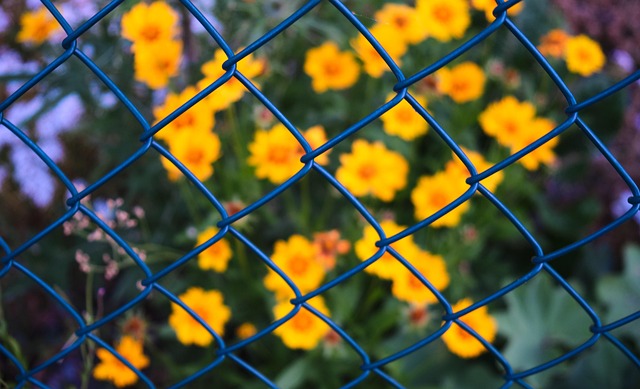Fences serve both functional and aesthetic purposes in our outdoor spaces. To enhance their beauty and protect against the elements, fence staining and sealing are essential practices. This comprehensive guide delves into the art of enhancing wooden fences through staining, exploring benefits, types, preparation, color choices, sealing techniques, application methods, and maintenance tips for a durable, visually appealing finish.
- Understanding Fence Staining: Benefits and Types
- Preparing Your Wooden Fence for Staining
- Choosing the Right Stain: Color Options & Formulas
- Sealing Techniques to Protect Your Fence
- Step-by-Step Guide: Applying Stain and Sealant
- Maintenance Tips for Longevity of Stained Fences
Understanding Fence Staining: Benefits and Types
Fence staining is not just about enhancing aesthetics; it’s a protective coat that can significantly prolong the life of your wooden fence. The process involves applying a liquid stain that seeps into the wood, blocking UV rays and preventing rapid deterioration caused by sunlight and weather conditions. This method offers a wide range of benefits, from increased durability to a diverse array of color options, allowing you to customize your outdoor space according to personal preference.
There are several types of fence stains available in the market, each with unique characteristics. Water-based stains are popular for their low odor and quick drying time, making them user-friendly. Oil-based stains, while taking longer to dry, offer superior durability and a richer color depth. Choosing the right type depends on factors like climate, desired color, and how often you’re willing to maintain and reapply the finish.
Preparing Your Wooden Fence for Staining
Before applying any stain or sealer to your wooden fence, proper preparation is key. Start by cleaning the fence thoroughly to remove any dirt, dust, or debris. Use a pressure washer if necessary, but be careful not to damage the wood fibers. Next, inspect the fence for any rot, cracks, or damaged boards and repair these issues before staining. Sanding the fence gently can help smooth out any rough patches and create a smoother surface for the stain to adhere to. Remove all dust and debris after sanding with a clean cloth or vacuum.
Once your fence is clean, dry, and repaired, it’s ready for staining. Ensure you have the right tools, such as high-quality brushes or rollers, and choose a suitable stain that matches your desired color and finish. Following the manufacturer’s instructions for application, make sure to apply an even coat of stain across the entire fence surface. This step will not only enhance the visual appeal but also protect the wood from environmental elements.
Choosing the Right Stain: Color Options & Formulas
When it comes to fence staining and sealing, selecting the perfect stain is a crucial step in achieving the desired look for your wooden fences. The market offers an extensive range of options, from solid colors to unique formulas designed to enhance wood grain. Color choices are virtually endless, allowing you to match any aesthetic preference or complement your outdoor space’s existing themes.
Consider the effect you wish to achieve—whether it’s a subtle enhancement of the wood’s natural tone, a rich, deep color, or an eye-catching, vibrant hue. Some stains provide long-lasting protection with UV resistance, ensuring colors remain vibrant and fresh for years. Others offer special effects like adding texture or creating distressed looks. Always read product labels carefully to understand the coverage, drying time, and maintenance requirements before making your selection.
Sealing Techniques to Protect Your Fence
When it comes to protecting your wooden fence, sealing is an essential step after staining. There are various techniques to choose from, each offering different levels of durability and aesthetics. One common method is applicator pad sealing, where a machine or handheld pad applies a sealant evenly across the fence’s surface. This technique is effective for large areas as it ensures quick coverage, but it may leave visible streaks if not done carefully.
An alternative is brush-on sealing, which allows for more control and precision. It’s ideal for intricate designs or hard-to-reach spots. However, this method can be time-consuming and requires a steady hand to achieve a consistent finish. Another modern approach is spray sealing, utilizing a pressure washer or specialized equipment to apply sealant in a fine mist. This technique offers excellent coverage and quick drying times but might not suit every fence style due to its uniform application.
Step-by-Step Guide: Applying Stain and Sealant
Applying stain and sealant to your wooden fence is a straightforward process that can transform its appearance and protect it from the elements. Begin by cleaning the fence thoroughly to remove any dirt, dust, or debris. Use a pressure washer or a stiff brush, ensuring the surface is free of contaminants for optimal adhesion. After cleaning, allow the fence to dry completely.
Next, select your desired stain color and apply an even coat using a brush or roller. Follow the manufacturer’s instructions regarding drying time between coats. Once the final coat has dried, it’s time for the sealant. Apply a generous layer of high-quality waterproof sealant, again using a brush or roller. This step will create a protective barrier against moisture, UV rays, and other environmental factors, ensuring your fence remains vibrant and durable for years to come.
Maintenance Tips for Longevity of Stained Fences
Regular maintenance is key to keeping your stained fence looking its best and ensuring its longevity. Here are a few simple tips to help you maintain your fence’s beauty:
1. Clean Regularly: Remove any dirt, debris, or mildew that may accumulate on the fence surface using a soft brush and mild detergent. This prevents build-up and keeps the stain looking fresh.
2. Reapply Sealant: Depending on the climate and exposure to elements, reapply a fresh coat of sealant every 1-3 years. This protective layer shields the wood from moisture, UV rays, and other environmental factors that can cause fading or deterioration.
